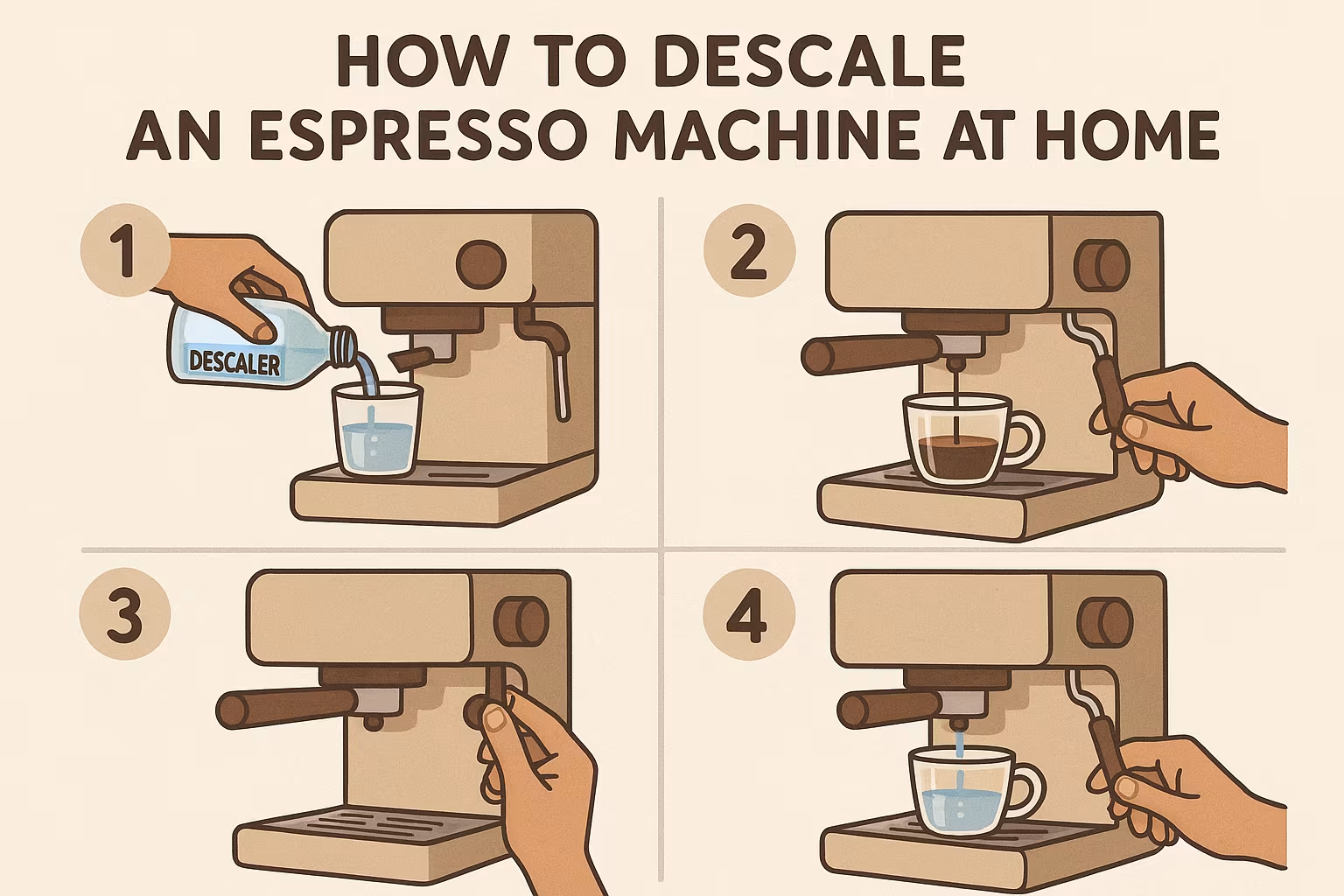Learn how to descale an espresso machine at home with simple steps. Discover natural solutions, recommended products, tips to prevent scale buildup, and maintenance practices to keep your espresso tasting perfect every day.
How to Descale an Espresso Machine at Home
There’s nothing quite like the aroma of a fresh espresso in the morning. But over time, even the best espresso machines lose their sparkle if we don’t give them proper care. One of the most essential maintenance steps is descaling, a process that removes mineral deposits, or limescale, that build up inside the machine.
Why Descaling Your Espresso Machine Matters
Many coffee enthusiasts underestimate the silent enemy inside their machines: limescale buildup. When water, especially hard water, passes through your espresso maker, it leaves behind minerals like calcium and magnesium. Over weeks and months, these minerals accumulate, clogging pipes, slowing water flow, and altering the heating system. The result? Bitter coffee, reduced machine efficiency, and eventually, costly breakdowns.
A study published by the Specialty Coffee Association (SCA) highlights that water quality and cleanliness are as important as the beans themselves. If you ignore descaling, your machine could suffer in performance just as a fine violin loses its tune when neglected. In short, descaling is the key to consistent quality, energy efficiency, and durability.
What is Limescale and How Does it Affect Coffee Quality?
Limescale is essentially hardened mineral deposits. It’s the chalky residue you may have noticed in kettles, taps, or showerheads. Inside an espresso machine, it coats heating elements and pipes.
Effects of limescale on coffee quality:
Uneven water flow: Mineral blockages prevent water from flowing smoothly through coffee grounds.
Altered temperature: Deposits interfere with heat transfer, leading to under-extraction or burnt flavors.
Bitter taste: Instead of the smooth, rich crema you expect, your espresso tastes flat or harsh.
Reduced aroma: Oils from coffee beans interact differently with mineral-coated surfaces, reducing fragrance.
“Coffee is 98% water. If the water is compromised, the coffee will never reach its full potential.” – James Hoffmann, World Barista Champion, 2007.
See more: How to Brew Coffee with a French Press Like a Pro
Signs Your Espresso Machine Needs Descaling
Like a car showing warning lights, your espresso machine gives signals when descaling is overdue. Watch out for:
Slower brewing times – Coffee takes longer than usual to pour.
Odd noises – Gurgling or hissing sounds during brewing.
Unusual taste – Bitter, metallic, or flat flavor instead of the rich espresso you love.
Less steam power – Frothing milk becomes weaker or inconsistent.
Warning lights – Many modern espresso machines (e.g., De’Longhi, Breville, Nespresso) have built-in descaling alerts.
If you’ve noticed two or more of these, it’s time to act.
Step-by-Step Guide: How to Descale an Espresso Machine at Home
Now let’s get practical. Here’s a detailed step-by-step process for descaling at home, whether you use a manual, semi-automatic, or fully automatic espresso machine.
Preparing Your Machine for Descaling
Before you begin:
Check your manual – Every brand has slight variations. Follow instructions from manufacturers like Breville, Gaggia, or De’Longhi.
Empty the water reservoir – Remove any remaining water.
Remove the filter basket and portafilter – These don’t need descaling but should be cleaned separately.
Ensure safety – Turn off the machine, unplug, and let it cool slightly before handling.
Using Commercial Descaling Solutions
Commercial descaling solutions are designed to dissolve limescale safely without damaging internal parts. Popular brands include Urnex Dezcal, Breville Eco Liquid, or Philips Saeco Descaler.
Steps to use:
Mix the solution with water according to the label (usually 1 part solution to 10 parts water).
Pour the mixture into the water tank.
Start the brew cycle without coffee, allowing the solution to run through.
Pause halfway to let the solution sit for 15–20 minutes, softening deposits.
Complete the cycle, then flush with at least two full tanks of clean water.
Pros: Effective, safe, and fast.
Cons: Extra cost compared to DIY alternatives.
How to Descale with Vinegar (Pros & Cons)
Vinegar is the most popular DIY descaling solution, but it comes with controversy.
How to use vinegar:
Mix equal parts white vinegar and water.
Run the solution through the machine as with commercial products.
Rinse thoroughly—at least 3–4 cycles of fresh water—to eliminate vinegar smell and taste.
Pros: Cheap, easily available, eco-friendly.
Cons: Can leave odor/taste if not rinsed well; may corrode seals in some machines.
Many experts suggest vinegar as an emergency option but recommend citric acid or commercial products for long-term care.
Best Natural Descaling Alternatives
If you prefer natural cleaning solutions to chemicals, you’re not alone. Eco-conscious coffee lovers often look for alternatives to commercial products.
Citric Acid Method
Citric acid, derived from citrus fruits, is a highly effective natural descaler.
How to use:
Mix 1 tablespoon citric acid with 1 liter of water.
Run through the machine like a standard descaling solution.
Flush with 2–3 cycles of clean water afterward.
Benefits: Natural, safe, odorless, affordable.
Drawbacks: Slightly less effective on heavy buildup compared to commercial solutions.
Baking Soda and Other DIY Methods
Baking soda isn’t typically used alone for descaling (since it doesn’t dissolve limescale well), but it’s excellent for cleaning external parts like the drip tray, portafilter, or milk frother.
Other methods people experiment with include lemon juice, but these may leave residue or odor if not rinsed thoroughly.
Tip: If you live in an area with very hard water (London, parts of the US Midwest, or Southern Europe), using filtered or bottled water in your espresso machine will reduce the need for frequent descaling.
Descaling Different Types of Espresso Machines
Different machines require slightly different approaches.
Descaling a Manual Espresso Machine
Manual machines, like La Pavoni lever models, need careful handling. Fill the boiler with descaling solution, heat slightly (not to full steam), and run it through gradually.
Descaling a Semi-Automatic Espresso Machine
Semi-automatic machines (e.g., Breville Barista Express) usually have clear instructions. You’ll run the descaling cycle, occasionally opening the steam wand to flush the solution through.
Descaling Fully Automatic & Pod Machines
Brands like Nespresso, Keurig, or Jura offer automatic descaling programs. Insert the descaler, press the descaling button, and the machine handles the rest. Pod machines often require more frequent descaling because of their small water tanks.
How Often Should You Descale Your Espresso Machine?
The golden question for every espresso lover is: how often should I descale my espresso machine at home? The answer depends on several factors, most importantly the hardness of your water and how frequently you brew coffee.
Soft water areas: Every 3–4 months is typically sufficient.
Moderately hard water: Every 2 months is recommended.
Very hard water: Monthly descaling may be necessary.
High usage (coffee shops, offices, or families with heavy coffee habits): Once a month regardless of water type.
For reference, Nespresso suggests descaling every 300–400 cups, while Breville recommends every 60–90 days. If you’re unsure about your water hardness, many supermarkets sell simple water test strips for just a few dollars.
“An ounce of prevention is worth a pound of cure.” – Benjamin Franklin. Regular descaling is that ounce of prevention that saves your espresso machine from costly repairs.
Common Mistakes to Avoid When Descaling
Even with good intentions, many coffee lovers make mistakes when cleaning their machines. Avoid these pitfalls:
Not rinsing enough – Leaving solution or vinegar residue can ruin coffee taste.
Using harsh chemicals – Never use bleach or industrial cleaners. They corrode metal and seals.
Skipping the steam wand – Always run the solution through the milk frothing system.
Forgetting to check the manual – Every machine is slightly different; ignoring manufacturer advice risks damage.
Using vinegar too often – While effective, vinegar can wear down rubber gaskets with prolonged use.
A simple reminder: treat your espresso machine like a musical instrument. Just as a Stradivarius violin requires gentle care, your coffee maker thrives with thoughtful maintenance.
Frequently Asked Questions (FAQs)
Can I use vinegar instead of descaling solution?
Yes, vinegar is a natural descaler, but it must be rinsed thoroughly. Commercial solutions are generally safer and leave no odor. Many manufacturers warn against vinegar because of its acidity and impact on seals.
Is descaling the same as cleaning?
No. Cleaning removes coffee oils and residues, while descaling removes mineral deposits. Think of it as dusting versus deep cleaning. Both are necessary.
What happens if I never descale my machine?
Ignoring descaling shortens the life of your espresso machine. Expect bitter coffee, machine clogs, reduced steam, and eventually expensive repairs. In worst cases, the heating element burns out, costing more than the machine is worth.
Conclusion: Keep Your Espresso Machine in Perfect Shape
To recap, learning how to descale an espresso machine at home is one of the simplest yet most powerful ways to protect both your appliance and your coffee experience. From understanding the dangers of limescale, recognizing the signs of buildup, and mastering step-by-step descaling with either commercial or natural solutions, you now have the tools to take full control of your espresso ritual.

I’m Kara Chavez, and I love coffee. I like to create some of the best coffees around – espressos, lattes, macchiatos . I strive for perfection in my coffee-making skills, and I take great pride in providing a delicious cup of joe to my customers.
I’ve been working in the coffee industry for years now, and I know everything there is to know about making a perfect cup of coffee. My passion for coffee shines through in every cup that I make, and I hope that you’ll stop by soon so that I can share my love of coffee with you!

